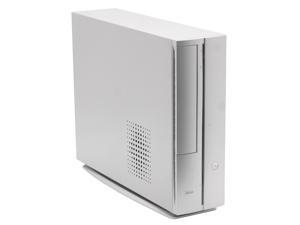Running SuSE Linux 9.3 on ASUS Pundit
June 2005 (497 Words, 3 Minutes)
Recently, I have finally decided to upgrade our home server. My wife’s old Dell Dimension 8200 that has been in this role for a while would move to a summer house as a main PC and I would get a new server.
After shopping around, I finally ended up with the following do-it-yourself configuration:

- ASUS Pundit barebone.
- Intel Celeron D 2.4GHz
- 512 MB of RAM
- Seagate 300GB hard drive
- Lite-On DVD writer.
Using ASUS Pundit as barebone seemed like a good idea. It is small, elegant, inexpensive, and it was said to have a good Linux support. The entire configuration cost $400+, which is significantly lower, compared to the Dell and HP prices for similar systems.
Much to my surprise, the configuration and installation was not quite as seamless as I expected it to be. At this point of time I usually take for granted the fact that Linux installs and runs seamlessly on most of hardware available. Installing Linux on my new server turned out to be more challenging and finding the solution was not a metter of a simple Google search.
Noise level
I was a bit scared after reading a couple reports about the supposedly loud noise emitted by the CPU fan. The fan turned out to be quite loud indeed but only when running at top speed. Setting the BIOS option for Q-FAN on make the fan go quiet. I am yet to see the amount of number crunching I have to run on the machine to get the fan loud again.
Wrong VCORE temperature
Turns out that Pundit’s default BIOS revision (1007) does not play nice with Celeron D CPUs, which results in a rather ominous BIOS halt with a message about a hardware problem. The problem reported is wrong VCORE temperature read by BIOS. The solution is to update the BIOS to revision 1010.
BIOS update
The Pundit’s manual is very detailed on the BIOS update procedure and it clearly explains each step of it: how to copy the update file to the floppy disk and how to tell the AFLASH program (or to the BIOS update routine) what the filename is. There is only one tiny problem: the system does not have a floppy drive!
The solution, graciously provided by Asus support, is to use the Asus Update program supplied on the CD (and not documented anywhere). Unfortunately, in order to use the program, one has to install Windows first, but the inconvenience is minor, especially when compared to other options, like trying to create a CD-ROM bootable into MS-DOS and posing as A: drive.
Disk geometry problems
It turns out, SuSE 9.3 installer has a bug when dealing with SIS-based
chipsets (like the one in Pundit). As a result, the installer kept
using wrong geometry information for my hard drive causing dozens of
scary IDE errors and telling me that my hard drive is actually only
half the size of what I thought it was (interestingly, none of the
other Linux distributions, including Knoppix, Fedora Core 3, and even
SuSE 9.1 exhibited this problem). The solution is to pass the option
insmod=ide-generic as a boot parameter when starting the
installer. See also SuSE Support
Page.
Power management
One thing that still doesn’t work is reboots and poweroffs. At the
point where the PC is to be rebooted of turned off, the system locks
up. I have tried various combinations of apm and acpi options but
with no success so far. I would appreciate if someone suggests a way
to deal with it.
Conclusion
Overall, Asus Pundit is a nice little box ideal for a small home server or an HTPC. Once I got the problems above resolved, I was good to go. and my new server keeps on humming in the corner. So far I am pretty happy with it and if it keeps that way, I will be soon buying another one for a home HTPC.